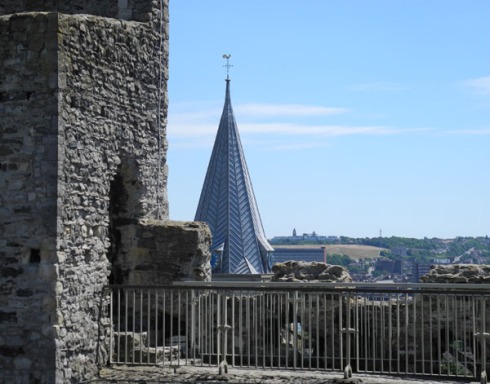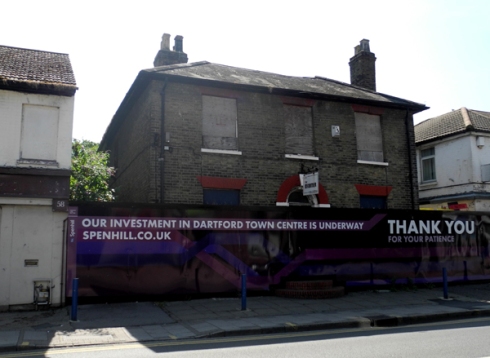You are currently browsing the monthly archive for July 2014.
How many pigs did it take to bring the wall down at Rochester Castle? Looking at the thick stone walls you may well think thousands. You may well thin how can a pig bring a wall down? During a siege 1215, led by King John, against rebellious barons pit props were used to shore up the keep when it was being pounded by siege engines. King John ordered that the props were to be set alight and they used the fat from forty pigs. This brought one of the corners crashing down. It was rebuilt later but the damaged area is still visible.
The Castle dates back to 1066 was originally a timber keep but was rebuilt of stone in the early C12th. It is strategically placed along the London Road and a crossing point on the River Medway.
It’s a massive stone structure used to protect from invaders coming up the Medway. Consisting of three floors and a basement, it stands 113 feet high. The floors no longer exist but you can still see the insets where the immense timbers rested. How did they get them up three floors? You can’t fail to be impressed with medieval engineering.
From the top of the tower you still get great views that remind you of the town’s proud history. Daniel Defoe visited in the 1720s this is what he wrote about the town:
“There is little remarkable in Rochester, except the ruins of a very old castle, and an ancient but not extraordinary cathedral: but the river, and its appendices are the most considerable of the kind in the world.”
The contours of the valley, the estuary and the North Downs are still an exceptional sight; perhaps no longer world class. Closer to the castle are the roof tops of the many Georgian buildings with beautiful patinas and decorative brick work and of course its majestic neighbour The Cathedral.
The view of the riverscape is about to change. Regeneration is about to begin, a new development Rochester Riverside my heart sinks not more luxury tall buildings that only foreign investors can afford.
However, this scheme looks more promising. It could even be unique; low to mid rise buildings along the riverside. The buildings will vary in height from one to eight storeys and vista corridors are planned so that the heritage views are protected. They are leaving one large blue crane as a nod to the industrial past of the town.
Rochester Castle
Reference
Daniel Defoe – A tour thro’ the whole island of Great Britain, divided into circuits or journies. 1724-28
Dartford may well thrive again but a walk through the historic market town leaves the distinct impression that the decline is terminal. Arriving by train one of the first sights is the abandoned Waitrose supermarket, continue through the Orchard shopping centre where there appears to be more vacant than occupied shop units. It’s a ghost town with little footfall to boost sales for those shops still clinging on.
Lowfield Street is awaiting demolition. Notices on the hoardings all along the street proclaim to residents and visitors that “it’s been worth the wait” and “not long to wait”.
Well the townspeople of Dartford have been waiting eleven years for this planning scheme to come to fruition. A new Tesco is coming to town bringing jobs and affordable homes. It’s good to know that there will be new jobs for the many retail staff who have recently lost their jobs, but is this a net gain?
Most historic market towns celebrate their heritage and try to preserve their fine buildings. Now, not all market towns can be preserved in aspic like Stamford in Lincolnshire but most find a way of balancing new development with the old. The buddleia growing out of the decorative brickwork of the remaining heritage buildings doesn’t fill you with confidence about their preservation.
Can Tesco regenerate the town? At the turn of the millenium that may have looked like a possiblity but since then Tesco has been losing market share, austerity kicked in and people have changed their shopping habits. Architecturally it will do nothing to make the place worth visiting. Its neighbour upstream at Woolwich has been shortlisted for the carbuncle prize. The former chair of Planning at the Royal Borough of Greenwich, Alex Grant, has stated that it’s a flawed project; a blight on the regeneration of the town and he regrets his role in its progeny. Oh dear it doesn’t bode well for Dartford.
Somewhere in Penhall Road Charlton there is a small replica of a London tramcar buried. A sign of remembrance for these much loved vehicles part of the London street scene since 1861. Rather than phasing out trams there was a final date – Last Tram Week 2nd July 1952. Tramway abandonment became a common phrase at the time as one Eltham resident explained to the Kentish Independent:
“In my opinion tramway abandonment is not a good policy, for no other vehicle can really replace a tram.”
He was not alone in this view, The Light Railway Transport League (formed 1939) proposed the retention of the London Tramway System modernising the transit system and better maintenance of the tramlines. The London Transport Executive refused to listen to the proposals and the tramway system was closed in its entirety. South East London would have been a very different place if the League’s proposals were accepted. The No 40 tramway ran from Plumstead Common to The Embankment and the No 46 from General Gordon Square to Cannon Street: commuter heaven. Woolwich would wait another fifty five years before they had a replacement rapid rail transit system.
Trams were to be replaced by buses which were thought to be more flexible and had the much lauded “internal combustion engine” as in 1952 no one had remotely thought of Peak Oil.
Londoners, were clearly fond of the trams. Thousands of people made sentimental last journeys collecting the last tickets as souvenirs. A crowd of 10-15,000 people waited at New Cross to see the last No 40 arrive at 12.29. A tram from Abbey Wood stopped at the Maybloom Club for a presentation to the driver and the conductor. The club had an extension until midnight and then the band turned out to play on the tram as it made its way to the breakers yard in Charlton. The Pearly Kings, not much seen on the streets of London now, were in on the act as well. They were busy in pubs and cafes across London making a “Farewell to the Trams” collection.













